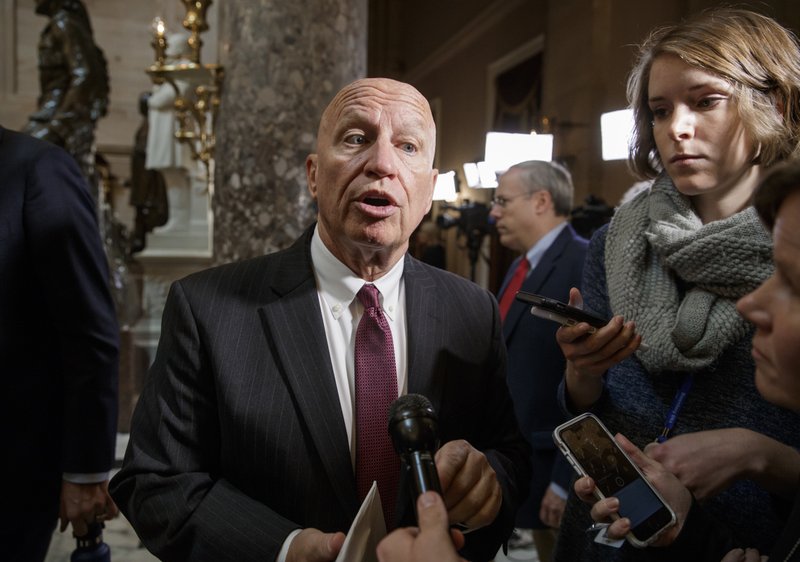WASHINGTON — The wealthiest Americans would benefit from the largest tax cuts under the House Republican overhaul, according to a nonpartisan analysis.
The Tax Policy Center on Monday found that in 2018, when the legislation pushed by President Donald Trump and Republican leaders would first take effect, 12 percent of people would see their tax bills rise. Next year, the average tax cut would be $1,100 under the legislation, but the amount would vary by income.
People earning less than $48,000 annually would see tax cuts of 0.5 percent or less of their after-tax income. The top 1 percent of earners — people making over $730,000 — would get an average cut of 2.5 percent, or $37,000.
In 2027, people making below $55,000 would get average tax boosts, not cuts. But the top 1 percent making over $912,000 would see average cuts of nearly $53,000, a 2.2 percent reduction.
The report came as the tax-writing Ways and Means Committee kicked off a marathon session to amend and vote on the far-reaching legislation that Trump hopes to sign into law by year's end. The panel's Republicans and Democrats argued heatedly over the effect of the legislation.
Republicans focused on findings by Congress' nonpartisan Joint Committee on Taxation that the bill would lower taxes across all income levels over the next several years.
"Clearly this is helping real people. It's helping teachers, it's helping students, it's helping struggling families that are living paycheck to paycheck," said GOP Rep. Erik Paulsen of Minnesota.
Democrats returned repeatedly to a section of the analysis showing taxes would actually go up beginning in 2023 for some 38 million taxpayers or families making $20,000 to $40,000 a year.
"There are a lot of people expecting a tax cut who would be big losers under this bill," proclaimed Democratic Rep. Bill Pascrell of New Jersey. "This is a joke, and you've got to face up to it."
At stake is whether the GOP will succeed in passing the most sweeping rewrite of the tax code in decades.
The legislation adds $1.5 trillion to the ballooning national debt, delivers a major tax cut to corporations, and repeals the estate tax, which would benefit a tiny percentage of the wealthiest families in the country. It also simplifies the loophole-ridden tax code by collapsing today's seven personal income tax brackets into four, nearly doubles the standard deduction used by people who don't itemize, and increases the child tax credit, an element championed by first daughter Ivanka Trump.
Despite the various analyses, Republicans argued that the legislation is targeted toward the middle class.
"It's about making America's economy stronger than ever by delivering more jobs, fairer taxes and bigger paychecks across the nation," said Ways and Means Committee Chairman Kevin Brady, R-Texas.
Brady is aiming to push the legislation through committee and to the full House later this week, and GOP leaders are aiming for House passage before Thanksgiving. Late Monday, he proposed additional changes, including restoring a tax break for employees who receive child care benefits from their employers and limiting the bill's impact on universities with large endowments.
The committee's top Democrat, Richard Neal of Massachusetts, countered that the bill "puts the well-connected first while forcing millions of American families to watch while their taxes go up." He complained that Republicans crafted it in private without input from Democrats.
The tax proposal is the first major rewrite of the U.S. tax code in three decades. After failures to make good on years of promises to repeal "Obamacare," the tax bill is enthusiastically backed by Trump, House GOP leaders and many rank-and-file Republicans, who are promising a simpler IRS code, a more globally competitive business tax structure, and tax cuts for the middle class and families with children.
But there's considerable trepidation as well. In addition to the overall increases in later years for lower-income Americans, many earners in the upper-middle class, especially those from high-tax states, are facing tax increases. That's because the measure would no longer permit taxpayers to deduct state income taxes from their federal taxes.
Lobbyists are fighting to protect favored deductions, while a few well-financed interest groups, including the National Association of Homebuilders, have already vowed to oppose the legislation. The homebuilders group has voiced concerns over Republicans' decision to lower the mortgage interest deduction from $1 million to $500,000.
Read Tuesday's Arkansas Democrat-Gazette for full details.
